When Hurricane Harvey made landfall near Rockport, Texas on August 25, 2017, Eddy Weiss had already assembled a team and was inbound. His consultancy, C4L & Associates, facilitates crisis response trainings, and also stands ready to serve in actual emergencies.
Outside Port Arthur, the C4L crew staged and awaited orders. It didn’t take long. Large mobile command vehicles were unable to traverse the compromised roads and sometimes knee-deep water. So Weiss, piloting a high-clearance, off-pavement capable Nomad Tactical Command Vehicle (TCV) received a State Police and National Guard escort into the heart of the affected area (view from the dash, top photo). The team quickly established command and communications at a temporary hospital, serving a rapid influx of patients in need.
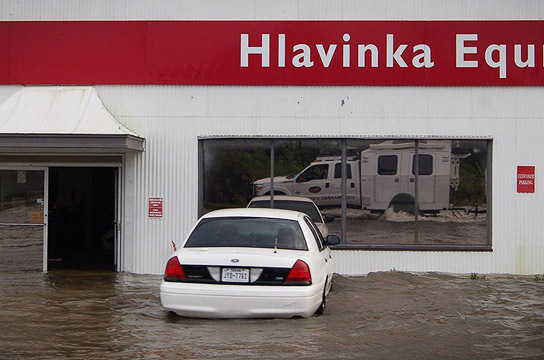 Nomad TCV (reflected) pushes into Port Arthur, TX
Nomad TCV (reflected) pushes into Port Arthur, TX
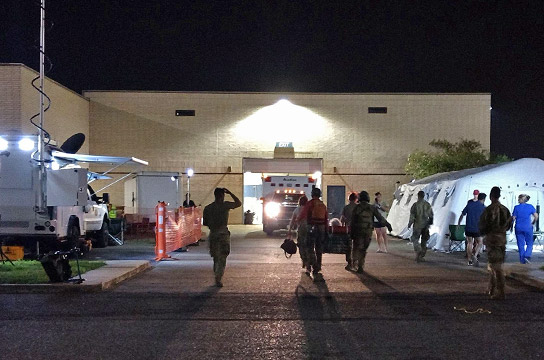 Makeshift hospital in a Texas box store warehouse
Makeshift hospital in a Texas box store warehouse
2017 was a storm season for the books. It was the costliest in U.S. history, surpassing even 2005, the disastrous year of Katrina, Rita, and Wilma. 2017’s hurricanes caused widespread destruction and loss of life in Texas, Florida, Puerto Rico, and the U.S. Virgin Islands. Communities will be managing the impacts of these disasters for years, and rebuilding will be a long process on a massive scale.
Agencies, businesses, and communities have an opportunity to learn from the 2017 season and develop a proactive strategy. Nomad customers and partners served in all of the year’s “big three” hurricanes (Harvey, Irma, and Maria), as well as many smaller storms. Here are a few key takeaways to apply in 2018 and beyond.
Lesson 1: Count on Complexity
The effects of natural and man-made disasters have become more frequent, far-reaching, and widespread.1 A burgeoning global population is, in many cases, developing into hazard-prone areas.2 Add increasing community expectations, the potential information distortion of modern media, and growing interdependency among agencies, and “complexity soup” is cooking on the front burner.
These trends are not likely to reverse but can, to some degree, be countered with forethought and preemptive action. The strategic concepts in this article can be set in motion today to help smooth the bumps when catastrophe strikes.
Lesson 2: Deploy, Train, Repeat
There is no substitute for time invested in the regular inspection, maintenance, and deployment of assets. Many equipment failures can be traced to simple lack of use. Mechanical systems are especially vulnerable to these “cobwebs.”
Terrell Bosarge of the U.S. Army Corps of Engineers (USACE) knows that, in an emergency, all systems must be running at 100-percent. “In terms of equipment, preparation is constant,” he said. “We do a complete monthly maintenance, top to bottom, front to back.”
Communications Support Team Lead for the Federal Aviation Administration (FAA), Anthony Funkhouser, concurs. “We try to deploy at least once a week to make sure everything is operational.” With each deployment, he will focus on a different system to rigorously test. Funkhouser even positions equipment in varying locations to assess environmental factors and connectivity.
Just as you should stretch the legs of your mobile operations assets, personnel should be regularly trained for procedural knowledge and technical proficiency. With geographically-dispersed or part-time squads, it can be a challenge. Funkhouser relates, “Many of my team members have other jobs, and may not have seen the truck for months. It’s important to keep them engaged and trained.” At the time of this writing, he was preparing an overnight deployment to do just that.
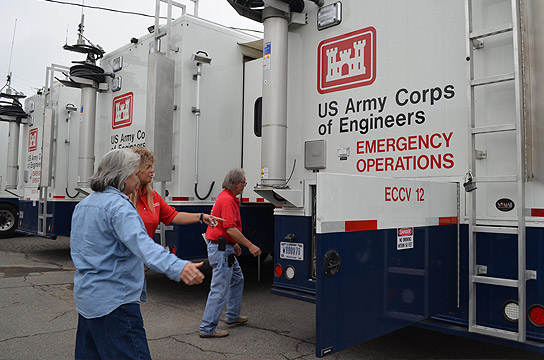 Nomad Emergency Command and Control Vehicle (ECCV) inspection
Nomad Emergency Command and Control Vehicle (ECCV) inspection
 USACE team on a three-day simulation exercise near Orland, CA
USACE team on a three-day simulation exercise near Orland, CA
Lesson 3: Know Your Neighbors
“You don’t want to exchange business cards at the scene of a disaster. You want to know your counterparts well before, so you have the connectedness to work the interagency process that is vital to a successful operation.” ~ General Craig McKinley (retd.)
Think for a moment about the concept of true integration. By fusing components, even if they appear on the surface to be different, you create a network stronger than any of the individual parts. Nomad applies this idea – no separate systems – to communications solutions, and it can be extended to emergency operations as well.
At a tactical level, strive for command and control interoperability. Anthony Funkhouser regularly attends mobile command vehicle “rodeos” for this purpose, running through a variety of training scenarios with other agencies. Plus, it’s always fun to see what the other guys have under the hood.
Strategically, try to be a silo buster. Public policy often divides emergency management into discrete areas, which can unfortunately lead to rivalries and the guarding of authority and resources. Work to develop an open dialogue with other agencies (especially volunteer groups, whose exposure to broader strategies and planning might be limited) and with the community as a whole. Position yourself and your agency as leaders, connectors who create collaborative networks for the greater good.
Extend this spirit of cooperation to the high-stress conditions of a disaster. Funkhouser recounts an experience from 2017. Deployed in Tallahassee, Florida during Hurricane Irma, the FAA air traffic control team was squeezed into a crowded command center building. Funkhouser offered the use of his mobile command vehicle. “They were so thankful to have a comfortable, quiet place to work,” he said.
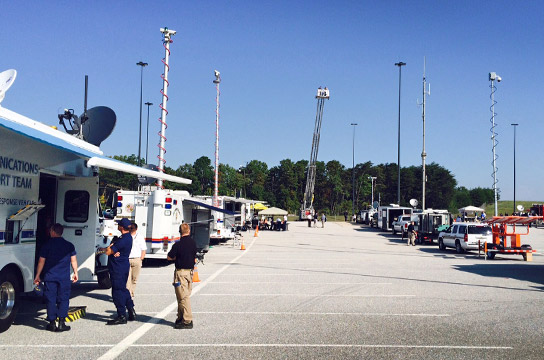 Nomad-built FAA vehicle (left) at a mobile command rodeo
Nomad-built FAA vehicle (left) at a mobile command rodeo
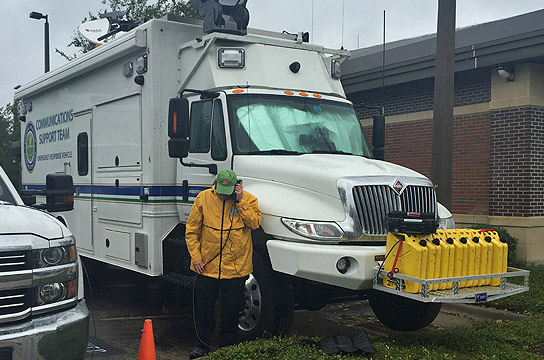 FAA command vehicle deployed in Tallahassee during Irma
FAA command vehicle deployed in Tallahassee during Irma
Lesson 4: Prepare to Pivot
A hurricane carries chaos in its winds. When that hurricane makes landfall, even the best-laid plans might need to be modified, restructured, or even abandoned. This kind of adaptive behavior will be aided by having multiple strategies at the outset, and being flexible enough to choose the best one for current conditions.
Consider the possibility that you might have unforeseen, last-minute procurement needs. After Hurricane Maria, the FAA required an air-transportable cargo trailer and called on Nomad to deliver. Luckily, there was a unit in stock and the agency had access to capital. In times of need, an accessible contingency fund can make all the difference. Mechanisms like GSA Disaster Recovery Purchasing and other simplified procurement programs can also be leveraged. Your mobile operations partner will guide you.
Minding small details also makes pivots less painful. Following Hurricane Maria, Terrell Bosarge needed to turn on a dime and move a significant number of USACE assets to Puerto Rico. Most, including several air-transportable Nomad MCV’s, carried the proper documentation. Unfortunately, others required hasty manual measurements, weighing, and certifications to satisfy the shipper’s requirements. “If I’d had those in hand ahead of time, the process would have been a lot smoother,” Bosarge said.
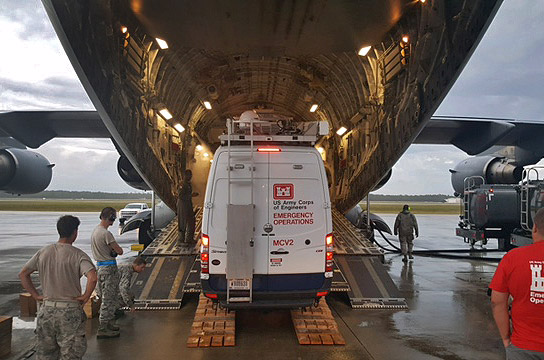 Nomad MCV loads onto a C-130 bound for Puerto Rico after Maria
Nomad MCV loads onto a C-130 bound for Puerto Rico after Maria
 The FAA moved quickly to secure this Nomad air-transportable trailer
The FAA moved quickly to secure this Nomad air-transportable trailer
Lesson 5: Measure and Report
With increasing competition for funds, jurisdictions are asking, “What are we getting for our money?” This drive to accountability demands agencies look at performance with a critical eye, in both emergency preparedness and response. Prove value in these areas, and you move up in line for future budget allocations. More importantly, you engage in a cycle of reflection, learning, and continuous improvement that may ultimately mean property and lives saved.
The essential questions that should be answered are:
- How does an agency know and demonstrate when preparedness is achieved?
- What are the measures of success in an emergency deployment?
- How can successful outcomes be achieved without a shift to unsafe or high-risk practices?
Terrell Bosarge counts utilization as one important metric. “For our program, the most successful aspect of the 2017 hurricane response was being able to exercise nearly every deployment team across all 11 of our districts. Everyone had the opportunity to gain experience in a real world event.”
The International Association of Emergency Managers (IAEM) offers a helpful guide for establishing your own success measures. // Download it Here
Bonus Lesson: Remember the Good You’re Doing
In the taxing conditions of a major hurricane, it’s understandable that emergency responders, public officials, utility crews, and volunteers might become hyper-focused on the tasks at hand. Keep this view in balance with the incredible relief you’re providing to those affected. The gratitude may be unspoken or delayed, but it is there.
Anthony Funkouser experienced this in 2017. “Getting communications back up for the FAA and assisting other agencies was rewarding, but the greatest honor came from the residents of the communities we responded to. The thank-you’s, after hearing stories of how they lost everything. People just waving, giving us thumbs-up. It means a lot.”
 Sunrise over Puerto Rico
Sunrise over Puerto Rico
Citations
1 “A Whole Community Approach to Emergency Management,” FEMA, 2011
2 “Challenges of Change in Future Emergency Management,” Owen, Bosomworth, Bearman, Brooks, et al, 2013
What mobile operations challenges have you experienced during storm events?
Let’s chat about how Nomad can help in the future.

